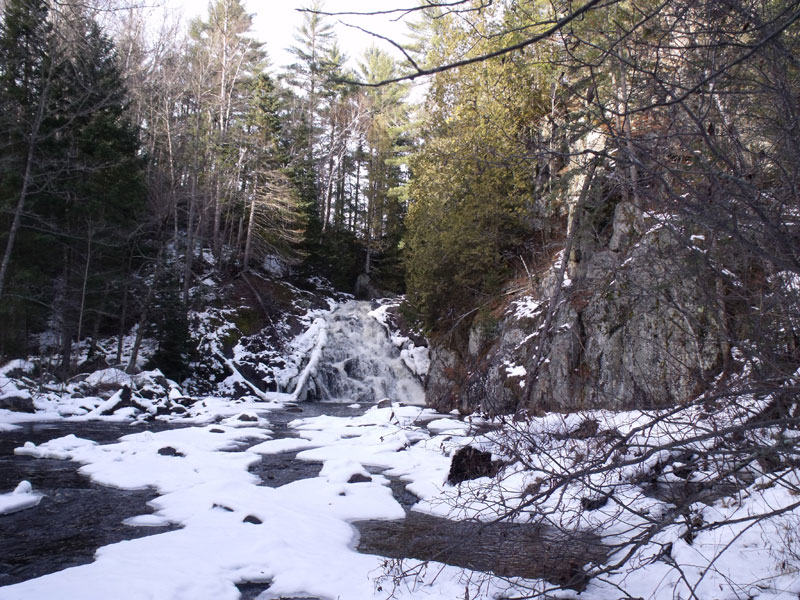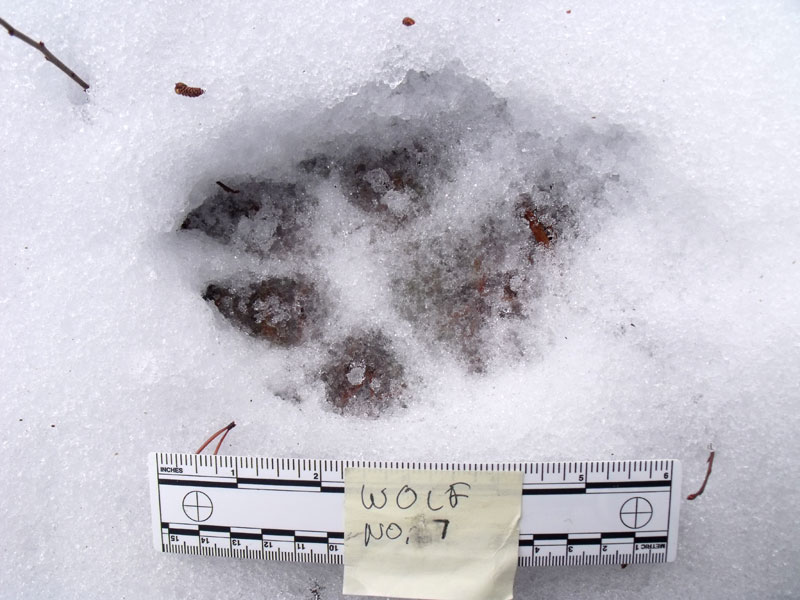*This article, written by Catherine Parker, was published in the Marquette Monthly December, 2017
An Encounter with Seven Wolves from the UP’s Northwestern Pack
“What more can life offer than the longed for unlooked for event when it happens?”
–Catullus
It isn’t often one has the privilege of seeing a wolf in the wild. An encounter with a pack is exceedingly rare. Although I’m a native of the Upper Peninsula, I’d never so much as glimpsed one of these elusive creatures until I ventured into the woods south of the Huron Mountains for a weekend of early winter camping.
My companion and I packed in a hurry on a December evening, stuffing food and gear into his van, and headed west on the Triple A Road into northwest Marquette County. Finding an appropriate place to spend the night can be a challenge on the dark two-tracks branching off the highway, but with the assistance of a plat book and a GPS device, it was one we readily embraced. We were, and are, after adventure, and sliding around on sloppy snow under a star-lit sky certainly qualifies, especially when there are unexpected obstacles, like fallen trees, that necessitate an occasional backward retreat.

An hour or so of looping through forested and deforested plats eventually led us to a small opening near a clear-cut, sheltered by encircling pines. Per our usual style, we tried out a comfortable-looking spot under a low-hanging bough, and calling it good, built a small fire by which to spend the evening.
The moon had not yet risen, so the sky was velvet black as I stepped away from the flicker and glow to embrace the dense band of stars marking the heart of the Milky Way. This is what I’m here for, I thought.
We talked by the fire till some unknown late hour, when bright-shining Orion and Cassiopeia were overcome by moonlight and common sense dictated we should both make our bed and lie in it. “It isn’t possible,” I told my companion, “for me to be any happier or more content than I am at this moment.” And so we slept on our mats, snug in our sleeping bags and bivy sacks, while a gentle winter wind blew through the branches over our heads like a lullaby.
We’d left Marquette and its green-brown lawns with the intention of trying a little gold-panning in the vicinity of the Yellow Dog Plains, but had forgotten that the highlands have a much different climate than our low-lying city by the lake. The half-foot of snow, consequently, put a literal damper on our plans. No sense in breaking through the thin layer of ice on the streams with boots or mitts in a half-hearted quest for precious metals, we decided, so after a leisurely Saturday morning breakfast, we loaded day packs and hiked to Pinnacle Falls, somewhat dissatisfied with our lack of agenda but enjoying ourselves, nonetheless.
After a late lunch on the side of a sunny ridge, we made the steep climb back to the van and went adventuring again, settling, just before dark, into the woods a bit north and west of our previous night’s location. We had no clear idea of what we would do the following day, and somewhat aimlessly perused gold-panning books and pamphlets by the fire in preparation for the next year’s excursion. Still, we were glad to be spending another night under open sky, and arranged our beds in a patch of red and jack pine, where soft mounds of lichen still lay bare of snow, and slept.
The following morning, my companion stirred himself from his slumbers and began layering on warm clothing. Since he’s the official fire-tender, I lagged a bit and didn’t sit up in my bag until he was already to the boot-lacing stage. We were talking quietly, with the van and remains of the fire in a clearing behind us, when I noticed something moving between the tree trunks some hundred or so meters away. I tapped my companion’s arm. “Animals,” I exclaimed softly, guessing they were the usual, ubiquitous deer.
Too small, I thought, almost instantly revising to coyotes. And as we sat, transfixed, a large, silver-tawny beast passed through an opening directly in front of us.
“Wolves,” my companion whispered, and I nearly stopped breathing as we watched, not one or two, but seven of these iconic creatures, in various sizes and shades of tan and brown, move silently across our field of view.

We both knew this was likely a once-in-a-lifetime experience, and one that we had nearly missed. If we hadn’t been sitting up, if we hadn’t been facing the woods at that exact time, if we’d been sleeping in a tent or in some other location…We felt profound gratitude and awe for what we had just witnessed. As for feeling threatened, the wolves didn’t seem to notice us, but trotted on, intent on some purpose. We postponed breakfast and set a course for the day. We would track wolves.
Excited, we rolled up sleeping pads and bags and loaded GPS and compass into our pockets, along with a pencil and small pad of paper. We would locate all seven sets of tracks, and determine their spacing and direction. This turned out to be a bit of a challenge, since the tracks of individual wolves occasionally crossed or disappeared into the bare spots under trees. But we did manage to make notes, based on pacing, on the distance between wolves, and arrived at a figure of 140 feet as an estimate of how far they were fanned out as they moved in a roughly easterly direction towards the headwaters of the Salmon Trout River.
I shot an azimuth from this grouping, hoping, with my compass reading, to achieve a closer approximation of their direction of travel, while my companion used GPS coordinates and a map to fix their last known location and locate the next linear feature, a two-track road the pack would cross if our calculations were correct and the wolves stayed their course. After breakfast, we would move on.

An hour later, we set out in the van with GPS on, both of us watching side windows for tracks as we approached the predicted crossing. Throughout the day, we would see prints of bear, coyote, snowshoe hare, deer, and four times, wolf. We were dead on with our first reading, finding seven sets of wolf tracks precisely where we’d anticipated they would be. Exhilarated, we repeated the process twice more, continuing about three miles, as the crow flies, down into the Salmon Trout drainage, where we found the last tracks just before nightfall. Intermingled with them, and scattered in all directions, were the distinct hoof prints of white-tailed deer.
Reluctantly, we climbed into our vehicle and headed home. We would return another day to try to catch sight of the wolves a second time. As if lightning really could strike twice. As if fortune really did favor the brave. As if the woods were our home, too.
–
Catherine Parker
Environmentalist and Writer

